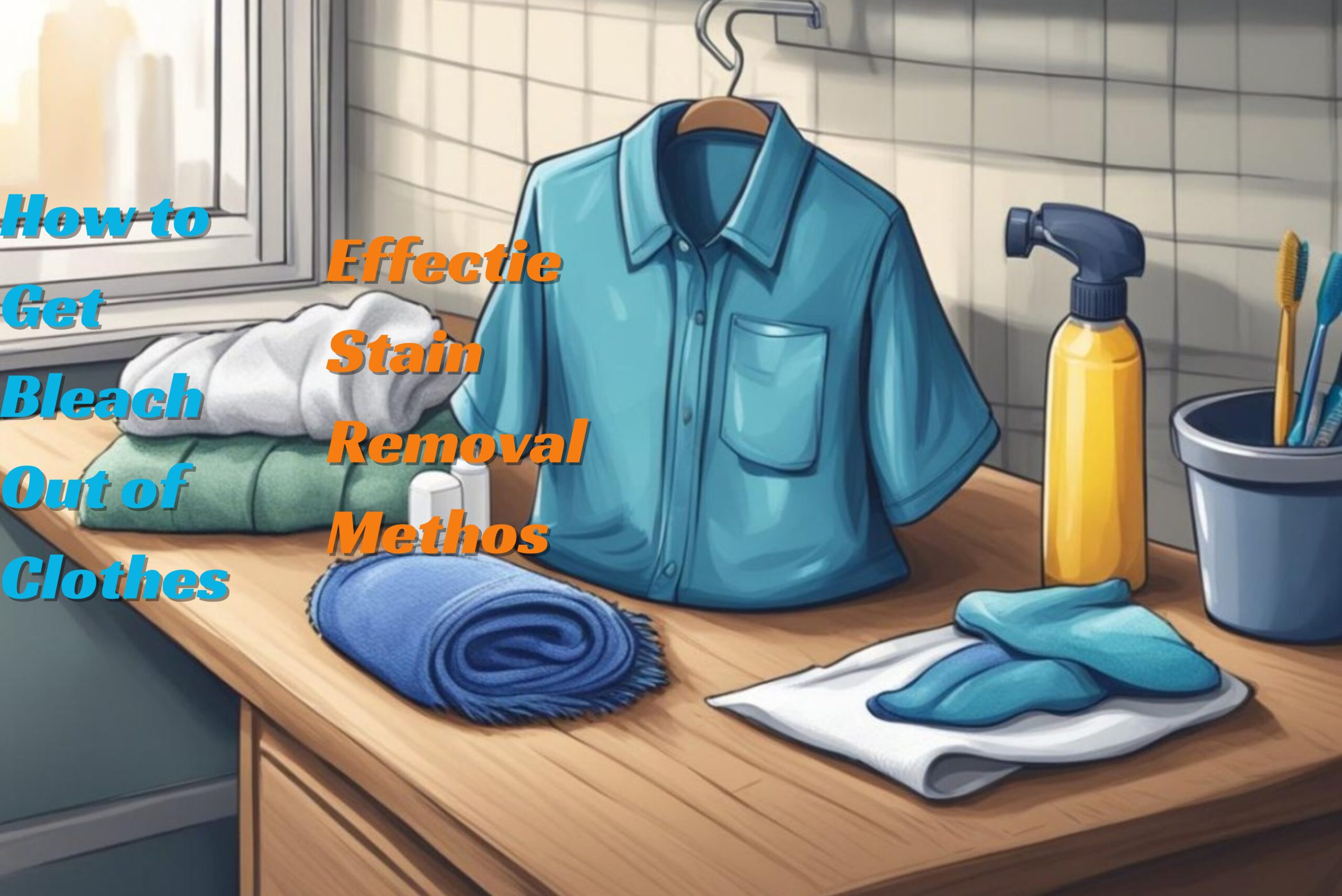Table of Contents
ToggleHow to Remove Bleach Stains from Clothes Expert Tips & Techniques
Learn tried-and-true techniques How to Restore Color and Remove Bleach from Clothes. Discover efficient ways to remove bleach stains from your beloved clothes and stop future deterioration, from DIY techniques to store-bought items. It might be annoying to have bleach stains on your clothing, particularly if you just spilled any.
But do not worry! You may successfully Remove Bleach Stains From Dark garments and bring your garments back to their former splendor with the correct methods and supplies. Now let’s explore some efficient ways to remove bleach from clothing quickly. Bleach stains are areas of light hue or white that are caused by bleach breaking down the dye molecules in materials.
Because they are permeable, fabrics like cotton and linen are especially prone to bleach stains. Take immediate action to reduce the harm. To start, blot as much bleach as you can from the afflicted area using a fresh cloth or paper towel. Next, use cold water to rinse the cloth in order to lessen the bleach’s effect and stop more discoloration.
Identifying the Stain Types of Bleach and Fabric Reactions
- Chlorine vs. Oxygen Bleach
Knowing what kind of bleach is used is essential before beginning the cleanup procedure. While oxygen bleach is kinder and often found in laundry solutions suitable for colors, chlorine bleach is a strong whitening ingredient that is frequently found in home cleansers.
In order to make stains simpler to remove, chlorine bleach works by dissolving their chemical bonds; nevertheless, it may also harm or discolor certain materials. Conversely, oxygen bleach lifts stains without the abrasiveness of chlorine bleach by releasing oxygen ions.
Sensitivity of Fabric
Different textiles respond to bleach in different ways. Wool and silk, for example, are very delicate and prone to damage, but certain materials, like chlorine bleach, may be able to tolerate it. It is advisable to consult the care label of the clothing before using any stain removal technique. To prevent further damage, it is advisable to use oxygen bleach or other stain removal methods on fragile materials.
Immediate Action Dealing with Fresh Spills
- Rinse with Cold Water
Move fast in case of recent spills. To prevent the bleach from setting into the fabric fibers, immediately rinse the affected area with cold water to dilute and remove it. Hot water may set stains permanently, so avoid using it.
Utilize Vinegar to Balance
If chlorine bleach is used, soak the clothing in a vinegar and water solution to remove any leftover residue. This lessens the alkaline effects of bleach and keeps the cloth from becoming any worse.
Because vinegar is acidic, it may efficiently counteract alkaline materials such as bleach. But in order to prevent further harming the cloth, it must be diluted with water.
Bleach Stain Removal Techniques
- Lemon Juice and Sunlight
Lemon juice and water may be used to remove bleach stains from white clothing. The stain can be treated immediately with this combination. After that, lay the clothing out in the sun. The sun’s UV rays and lemon juice will naturally bleach the fabric, lightening the stain.
Lemon juice’s inherent bleaching properties are enhanced by sunshine, because to the citric acid in the juice. But this technique works best on white textiles; it may not work well on delicate or colorful materials.
Solution of Hydrogen Peroxide
Make a solution of hydrogen peroxide and water and use it on the stained area to get rid of persistent stains. After a few minutes, let it settle before blotting with a fresh towel. Continue as needed until the stain disappears.
An oxidizing substance that works well in removing bleach stains from cloth is hydrogen peroxide. To make sure it doesn’t result in any negative responses, it’s crucial to test it first on a little, discrete region.
Business-Used Stain Remover
Commercial stain removers designed expressly to tackle bleach stains are widely available on the market. For best results, look for products that include oxygen bleach or enzymes.
The purpose of these stain removers is to specifically target and eliminate bleach stains without harming the cloth. To get the best results, please follow the manufacturer’s directions.
Remove Bleach Stains From Grey Clothes
Try these techniques to get rid of bleach stains on gray clothing:
Dye the cloth: If the bleach stain is large and will not go away with previous techniques, think about dying the cloth a deeper gray or a color that will hide the stain.
Fabric Marker or Dye Pen: Apply color over the bleach stain using a fabric marker or dye pen. Small stains respond best to this technique, which may also help the stain disappear into the cloth.
Fabric Paint: To hide the bleach stain, paint it with fabric paint. Pick a paint shade that comes the closest to complementing the gray cloth.
Fabric Patch or Applique: If the bleach stain is visible on the garment, you may want to think about using a fabric patch or appliqué to conceal it. This may be a pretty method to cover up the stain.
Reverse Bleach: To undo the effects of the bleach, add a dye remover or bleach neutralizer to the damaged area. Test the product on a little, discrete section of the cloth first, then carefully follow the directions on the packaging.
Professional Restoration: You may choose to take the clothing to a professional fabric restorer or cleaner if the stain is really difficult to remove or if you don’t feel comfortable trying to remove it yourself. They could have goods and methods specifically designed to help repair the cloth.
Preventive Measures Avoiding Future Mishaps
- Separate Whites and Colors
While doing washing, remove bleach stains from colored clothing. By doing this, the chance of cross-contamination is decreased and bleach is only used when required.
The color and integrity of your clothing may be preserved and bleach mishaps can be avoided by simply sorting your clothes into different piles before washing.
Make use of color-safe bleach substitutes.
When bleaching or lightening colored textiles, choose alternatives that are safe for colored materials. These products are less prone to harm or discolor the fibers and are kinder on them.
Alternatives to color-safe bleach include oxygen bleach or other mild whitening solutions that are safe to use on colored textiles. They remove stains well without sacrificing the color brilliance of your clothing.
Use bleach sparingly.
Wear protective gloves and clothes while handling bleach to prevent skin irritation and spillage. It is recommended to keep bleach out of the reach of children and pets and to always use it according to the manufacturer’s instructions.
Because bleach is a strong chemical, using it carefully will help to avoid mishaps and injury. You may use bleach safely and risk-free for washing purposes if you take the right measures.
How Do You Remove Bleach Stains From Clothes?
To remove bleach stains from clothes, follow these steps:
- Move Fast: To absorb excess bleach, dab the impacted area as soon as you see a spill using a fresh cloth or paper towel.
- Rinse with Cold Water: To lessen the bleach’s effects and stop the stain from spreading further, rinse the cloth with cold water. Hot water might set the bleach stain, so avoid using it.Try the Vinegar Solution: Combine equal amounts of white vinegar and water, then apply the mixture to the bleach stain. After a few minutes, let it rest and then rinse with cold water.
Use Lemon Juice and Salt: Combine the lemon juice and salt to make a paste, which you should then gently press over the bleach stain. After letting it rest for approximately half an hour, give it a good rinse.
Use Hydrogen Peroxide: Douse the bleach stain directly with hydrogen peroxide, allowing it to soak for a few minutes before washing. When using hydrogen peroxide on colorful clothes, use caution as it may cause fading. - Think About Commercial Products: Search for stain remover sprays or pens made especially for removing bleach stains. For optimal results, adhere to the directions on the product label.
Prevent Future Stains: To prevent future accidents, use color-safe bleach substitutes or dilute bleach with water before use. Any cleaning solution should always be tested first in a discrete location.
Seek Professional Assistance: If the bleach stain is really difficult to remove or if it has persisted for a long time, you may want to think about hiring stain removal experts.
How Do You Fix Bleach Damaged Clothes?
Determine the extent of the damage and choose the best repair technique for clothing ruined by bleach. This might include coloring the clothing, repairing any tears or weak spots, using vinegar or hydrogen peroxide to neutralize the bleach, or getting expert restoration.
To guarantee a successful repair, carefully follow each method’s instructions. Additionally, read labels, do spot tests, and dilute bleach before using it for laundry as preventative steps to prevent bleach damage in the future.
How To Take Out Acrylic Paint From Clothes
Take quick action to remove acrylic paint off clothing. First, use a dull knife or spoon to carefully scrape off any extra paint. Next, to dilute the paint, rinse the area discolored with acrylic paint with cold water. Hot water may set stains, so avoid using it. The acrylic paint stain should then be immediately treated with a pre-treatment stain remover or liquid laundry detergent, and let to settle for a few minutes. After that, use a strong washing detergent and wash the item in the warmest water possible for its material.
How Do You Remove Bleach Dye From Clothes?
Although it might be difficult to remove bleach color stains off clothing, there are a few techniques you can attempt to lessen the damage:
Soak in Vinegar:
White Clothes: Remove Yellow Bleach Stains. Mix equal quantities white vinegar and water to make a solution, then soak the soiled item for a few hours. Vinegar may aid in bleach neutralization and color stain lightening.
Hydrogen Peroxide:
Directly apply hydrogen peroxide to the bleach dye. Before washing with cold water, remove bleach stains from clothing and let them rest for a few minutes. Continue as needed until the stains disappear.
Neutralizer for bleach:
Certain commercial products are made expressly to remove stains caused by bleach. When using these goods, strictly adhere to the manufacturer’s directions.
Color Eliminator:
It could be necessary to apply a color removal product if the bleach dye stains are really bad. Make careful to test the product on a tiny, discrete part of the garment first, as instructed on the product box.
Expert Repair:
Consider getting expert assistance from a textile restoration specialist if the clothing is priceless or fragile. With their knowledge and equipment, they can evaluate the damage and make repairs that will lessen the visibility of bleach dye stains.
.
Is Bleach An Effective Stain Remover?
Indeed, bleach is a useful stain remover, especially for stubborn stains like those left by wine, tea, or coffee. Particularly recognized for its potent whitening and cleansing qualities, chlorine bleach is useful for dissolving and getting rid of stains from textiles.
But, bleach may harm certain materials and create discoloration if not handled appropriately, so it’s imperative to use it carefully and take safety measures. Furthermore, stains may be successfully removed using oxygen bleach, a milder substitute that doesn’t have the same negative consequences as chlorine bleach.












